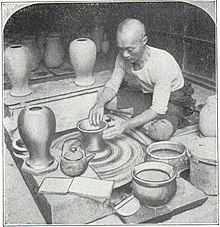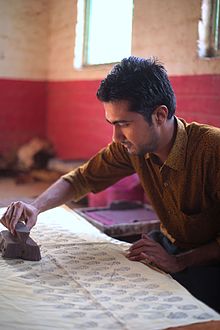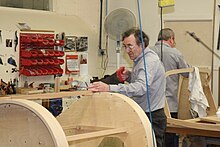User:Dilettante Army/sandbox
Craft page
*integrate American craft hatnote early
New intro:
A craft or trade is a pastime or an occupation that requires particular skills and knowledge of skilled work.
Craft is a pastime or occupation that involves process-oriented practices of making, often functional objects.
Craft is a pastime or occupation that involves process-oriented practices of making. These processes often result in functional objects.
hand, skill, production of goods
Craft is a pastime or occupation that involves a wide array of making practices.
functionality
handwork
skill
trade vs. craft
education/apprenticeship
transforming materials
"skilled making on a human scale"
knowledge or intelligent making
Craft is a pastime or occupation that involves skilled practices of making, material exploration, or handwork. Crafted objects are often functional or reference functional objects. Since the Industrial Revolution, craft has acquired additional meaning in opposition to manufacturing and industry, emphasizing a complete, self-directed process and the production of unique objects. In a wider sense, "craft" can mean attention to technique or careful execution, regardless of material or process.
A craft or trade is a pastime or an occupation that requires particular skills and knowledge of skilled work. In a historical sense, particularly the Middle Ages and earlier, the term is usually applied to people occupied in small scale production of goods, or their maintenance, for example by tinkers. The traditional term craftsman is nowadays often replaced by artisan and by craftsperson (craftspeople).
Craft is a practice of making centered on material exploration and handwork.
Craft objects are often included in the fields of design, decorative arts, fine art, or folk art. As in art, no absolute criteria exist for judging whether a particular object is craft, but some criteria include functionality or reference to functionality, material specificity, and handwork. Craft practice can be characterized by skill, attention, and long practice. Contemporary craft artists often work against these expectations.
Craft education—apprenticeship model, learning by doing. Informal education accomplished in the home, community workshops, or other sites where learning is not systematized or credentialed.
tradesmen, tradespeople
occupation
NOTE: two different pages for Folk Art and Folk Arts: Folk art, Folk arts
More global focus on traditional five mediums:
Benin bronzes Benin Bronzes
Mamluk carved wooden screens (like: https://collections.vam.ac.uk/item/O370838/panel/, History of wood carving)
Venetian glass Venetian glass
Chinese lacquerware Lacquerware
Chancay weaving Andean textiles
Sailmaking Sailmaker
Knitting
Old paragraph with some new additions:
In European history, the more specialized crafts with high-value products tended to concentrate in urban centers and formed guilds. The skill required by their professions and the need to be permanently involved in the exchange of goods often demanded a generally higher level of education, and craftsmen were usually in a more privileged position than the peasantry in societal hierarchy. Craft artisans in medieval Europe developed extensive and powerful guilds that regulated professional standards and prices. When an apprentice finished his apprenticeship, he became a journeyman searching for a place to set up his own shop and make a living. After he set up his own shop, he could then call himself a master of his craft.Some crafts, especially in areas such as pottery, woodworking, and various stages of textile production, could be practiced on a part-time basis by those also working in agriculture, and were practiced by peasantry as well.
Many craft institutions in Europe and the U.S. have roots in the Arts and Craft Movement, which aimed to preserve handicraft as dignified and skilled work in the midst of the Industrial Revolution, which depended on repetitive and dull factory work.
In the American studio craft movement of the 20th century, craft was associated with five main mediums (ceramics, metals, fiber, wood, and glass) that had been historically used by tradesmen and artisans rather than by painters and sculptors. While these mediums are still associated with contemporary craft, more expansive definitions are also deployed. Traditional and everyday forms of making things by hand exist all over the world and throughout human history. In its broadest definition, craftsmanship is present in all societies. In craft scholar Glenn Adamson's brief summation, craft is simply "skilled making at a human scale."[1]
A craft or trade is a pastime or an occupation that requires particular skills and knowledge of skilled work. In a historical sense, particularly the Middle Ages and earlier, the term is usually applied to people occupied in small scale production of goods, or their maintenance, for example by tinkers. The traditional term craftsman is nowadays often replaced by artisan and by craftsperson (craftspeople).
Historically, the more specialized crafts with high-value products tended to concentrate in urban centers and formed guilds. The skill required by their professions and the need to be permanently involved in the exchange of goods often demanded a generally higher level of education, and craftsmen were usually in a more privileged position than the peasantry in societal hierarchy. The households of craftsmen were not as self-sufficient as those of people engaged in agricultural work, and therefore had to rely on the exchange of goods. Some crafts, especially in areas such as pottery, woodworking, and various stages of textile production, could be practiced on a part-time basis by those also working in agriculture, and often formed part of village life.
This stepwise approach to mastery of a craft, which includes the attainment of some education and skill, has survived in some countries until today. But crafts have undergone deep structural changes since and during the era of the Industrial Revolution. The mass production of goods by large-scale industry has limited crafts to market segments in which industry's modes of functioning or its mass-produced goods do not satisfy the preferences of potential buyers. As an outcome of these changes, craftspeople today increasingly make use of semi-finished components or materials and adapt these to their customers' requirements or demands. Thus, they participate in a certain division of labour between industry and craft.
Sections:
- Traditional handicraft: pottery, lace, knitting, weaving, spinning, basket weaving, glassblowing, beadwork, leatherwork, quilting, bookbinding, origami, wood carving, blacksmithing, silversmithing, etc. Look at Outline of Crafts for other examples.
- Arts and Crafts movement
- Studio craft: Southern Highlands Handicraft Guild, Penland, Black Mountain College, Cranbrook, Bauhaus, Aileen Osborn Webb, American Craft Council, Museum of Contemporary Craft, HBCU craft programs (Makers p. 195), New Deal funding, GI Bill, Southern Highlands Handicraft Guild, Penland, Black Mountain College, Cranbrook, Bauhaus
- DIY
- Countercultures, art-to-wear
- 90s craft revival, Renegade
- Contemporary craft (including craft fairs and notable artists), American Craft Magazine and other publications
From Shannon's piece:
1. Craft as field of practice: a category of material exploration, as in the American craft movement, wherein work is made from clay, fiber, glass, wood, or metal (the latter medium usually takes the form of personal ornamentation, as in studio jewelry, but also includes utensils or tools).
2. Craft as noun: a category of objects that are functional and handmade. This could arguably also be labeled design; no material specificity required.
3. Craft as verb: a shortened version of “handcraft,” implying making by hand, regardless of material. This usage focuses on the labor of an individual maker.
4. Craft as verb: a loftier application of the preceding usage, referring to a practitioner’s skill in completing their work and perhaps their attention to that work—for example, “the writer’s craft,” referring to their voice, word choice, sentence structure, etc. See Richard Sennett’s The Craftsman.
5. Craft as adjective: used to label and categorize an object, usually in opposition to art and frequently encompassing the materials listed above; used derogatorily in relation to handmade objects of any kind whose materiality, form, surface, ideas, or execution in general is out of step with the prevailing conventions of “fine art.”
Studio craft movement
chronology:
- arts and crafts movement, industrial revolution
- Southern Highlands Handicraft Guild, Penland, Black Mountain College, Cranbrook, Bauhaus
- Aileen Osborn Webb, American Craft Council, Museum of Contemporary Craft
- HBCU craft programs (Makers p. 195)
- New Deal funding
- GI Bill
Ceramics: Marguerite Wildenhain, Bernard Leach, Shoji Hamada, mingei, Peter Voulkos, Karen Karnes,
This article needs additional citations for verification. (April 2017) |



A craft or trade is a pastime or an occupation that requires particular skills and knowledge of skilled work. In a historical sense, particularly the Middle Ages and earlier, the term is usually applied to people occupied in small scale production of goods, or their maintenance, for example by tinkers. The traditional term craftsman is nowadays often replaced by artisan and by craftsperson (craftspeople).
Historically, the more specialized crafts with high-value products tended to concentrate in urban centers and formed guilds. The skill required by their professions and the need to be permanently involved in the exchange of goods often demanded a generally higher level of education, and craftsmen were usually in a more privileged position than the peasantry in societal hierarchy. The households of craftsmen were not as self-sufficient as those of people engaged in agricultural work, and therefore had to rely on the exchange of goods. Some crafts, especially in areas such as pottery, woodworking, and various stages of textile production, could be practiced on a part-time basis by those also working in agriculture, and often formed part of village life.
When an apprentice finished his apprenticeship, he became a journeyman searching for a place to set up his own shop and make a living. After he set up his own shop, he could then call himself a master of his craft.
This stepwise approach to mastery of a craft, which includes the attainment of some education and skill, has survived in some countries until today. But crafts have undergone deep structural changes since and during the era of the Industrial Revolution. The mass production of goods by large-scale industry has limited crafts to market segments in which industry's modes of functioning or its mass-produced goods do not satisfy the preferences of potential buyers. As an outcome of these changes, craftspeople today increasingly make use of semi-finished components or materials and adapt these to their customers' requirements or demands. Thus, they participate in a certain division of labour between industry and craft.
Classification[edit]
There are three aspects to human creativity[according to whom?] - art, crafts, and science. Roughly determined, art relies upon intuitive sensing, vision and expression, crafts upon sophisticated technique and science upon knowledge.

Handicraft[edit]
Handicraft is the "traditional" main sector of the crafts, it is a type of work where useful and decorative devices are made completely by hand or by using only simple tools. The term is usually applied to traditional means of making goods. The individual artisanship of the items is a paramount criterion, such items often have cultural and/or religious significance. Items made by mass production or machines are not handicraft goods. Handicraft goods are made with craft production processes.
The beginning of crafts in areas like the Ottoman Empire involved the governing bodies requiring members of the city who were skilled at creating goods to open shops in the center of town. These people slowly stopped acting as subsistence farmers (who created goods in their own homes to trade with neighbors) and began to represent what we think of a "craftsman" today.[2]
In recent years, crafts and craftspeople have slowly been gaining momentum as a subject of academic study. For example, Stephanie Bunn was an artist before she became an anthropologist, and she went on to develop an academic interest in the process of craft - arguing that what happens to an object before it becomes a 'product' is an area worthy of study.[3]

The Arts and Crafts Movement[edit]

The term crafts is often used to describe the family of artistic practices within the family of decorative arts that traditionally are defined by their relationship to functional or utilitarian products (such as sculptural forms in the vessel tradition) or by their use of such natural media as wood, clay, ceramics, glass, textiles, and metal.
The Arts and Crafts Movement originated in Britain during the late 19th century and was characterized by a style of decoration reminiscent of medieval times. The primary artist associated with the movement is William Morris, whose work was reinforced with writings from John Ruskin. The movement placed a high importance on the quality of craftsmanship, while emphasizing the importance for the arts to contribute to economic reform.
Studio crafts[edit]
Crafts practiced by independent artists working alone or in small groups are often referred to as studio craft. Studio craft includes studio pottery, metalwork, weaving, woodturning, paper and other forms of woodworking, glassblowing, and glass art.
Craft fairs[edit]
A craft fair is an organized event to display and sell crafts. There are craft stores where such goods are sold and craft communities, such as Craftster, where expertise is shared.
Tradesperson[edit]
A tradesperson is a skilled manual worker in a particular trade or craft. Economically and socially, a tradesperson's status is considered between a laborer and a professional, with a high degree of both practical and theoretical knowledge of their trade. In cultures where professional careers are highly prized, there can be a shortage of skilled manual workers, leading to lucrative niche markets in the trades.
See also[edit]
|
Communities[edit]
|
References[edit]
- ^ "The Queue: Glenn Adamson". American Craft Council. Retrieved 2022-11-12.
- ^ Suraiya., Faroqhi (2014-01-01). Artisans of Empire : Crafts and Craftspeople Under the Ottomans. I.B. Tauris. p. 119. ISBN 9780857710628. OCLC 956646181.
- ^ Ingold, Tim (2011). Redrawing Anthropology: Materials, Movements, Lines. Farnham: Ashgate Publishing Limited. pp. 21–22.
External links[edit]
![]() Media related to Crafts at Wikimedia Commons
Media related to Crafts at Wikimedia Commons
